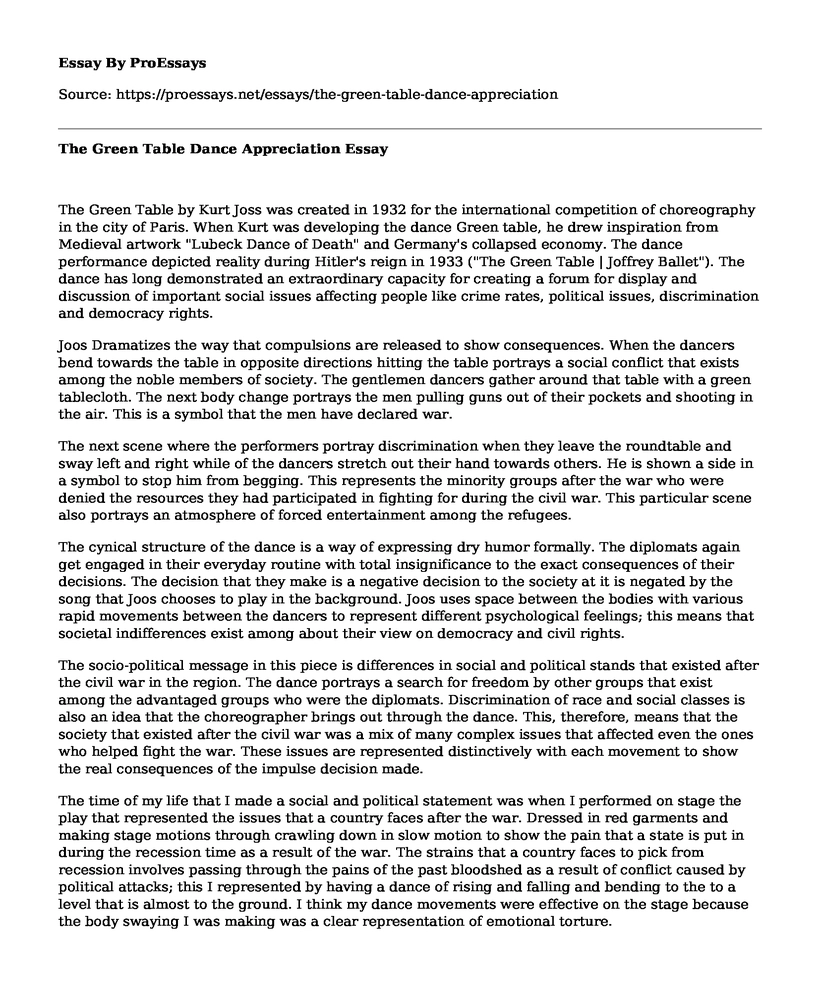The Green Table by Kurt Joss was created in 1932 for the international competition of choreography in the city of Paris. When Kurt was developing the dance Green table, he drew inspiration from Medieval artwork "Lubeck Dance of Death" and Germany's collapsed economy. The dance performance depicted reality during Hitler's reign in 1933 ("The Green Table | Joffrey Ballet"). The dance has long demonstrated an extraordinary capacity for creating a forum for display and discussion of important social issues affecting people like crime rates, political issues, discrimination and democracy rights.
Joos Dramatizes the way that compulsions are released to show consequences. When the dancers bend towards the table in opposite directions hitting the table portrays a social conflict that exists among the noble members of society. The gentlemen dancers gather around that table with a green tablecloth. The next body change portrays the men pulling guns out of their pockets and shooting in the air. This is a symbol that the men have declared war.
The next scene where the performers portray discrimination when they leave the roundtable and sway left and right while of the dancers stretch out their hand towards others. He is shown a side in a symbol to stop him from begging. This represents the minority groups after the war who were denied the resources they had participated in fighting for during the civil war. This particular scene also portrays an atmosphere of forced entertainment among the refugees.
The cynical structure of the dance is a way of expressing dry humor formally. The diplomats again get engaged in their everyday routine with total insignificance to the exact consequences of their decisions. The decision that they make is a negative decision to the society at it is negated by the song that Joos chooses to play in the background. Joos uses space between the bodies with various rapid movements between the dancers to represent different psychological feelings; this means that societal indifferences exist among about their view on democracy and civil rights.
The socio-political message in this piece is differences in social and political stands that existed after the civil war in the region. The dance portrays a search for freedom by other groups that exist among the advantaged groups who were the diplomats. Discrimination of race and social classes is also an idea that the choreographer brings out through the dance. This, therefore, means that the society that existed after the civil war was a mix of many complex issues that affected even the ones who helped fight the war. These issues are represented distinctively with each movement to show the real consequences of the impulse decision made.
The time of my life that I made a social and political statement was when I performed on stage the play that represented the issues that a country faces after the war. Dressed in red garments and making stage motions through crawling down in slow motion to show the pain that a state is put in during the recession time as a result of the war. The strains that a country faces to pick from recession involves passing through the pains of the past bloodshed as a result of conflict caused by political attacks; this I represented by having a dance of rising and falling and bending to the to a level that is almost to the ground. I think my dance movements were effective on the stage because the body swaying I was making was a clear representation of emotional torture.
Works Cited
"The Green Table (Kurt Jooss)(Joffrey Ballet Chicago) DVD." YouTube, 8 Oct. 2013, www.youtube.com/watch?v=FaZQsZUsytc.
"The Green Table | Joffrey Ballet". Joffrey.Org, 2018, http://joffrey.org/performances/productions/green-table. Accessed 13 Dec 2018.
Cite this page
The Green Table Dance Appreciation. (2022, Mar 09). Retrieved from https://proessays.net/essays/the-green-table-dance-appreciation
If you are the original author of this essay and no longer wish to have it published on the ProEssays website, please click below to request its removal:
- Trifle Drama Essay Example
- Essay Sample on Media Influence on Society
- The Royal Art of the Kingdom of Benin: A Classical Form Political Propaganda Essay
- Doping Scandal Exposes Russia's State-Sponsored Olympic Program: Essay Sample on Icarus Documentary
- Essay Example on Thesis Statement: A Crucial Element of Academic Writing
- Social Media: Impacting Society Positively & Negatively - Essay Sample
- Essay Example on Smartphones: Revolutionizing Communication and Convenience







